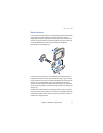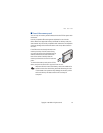
Introduction
Copyright
©
2007 Nokia. All rights reserved.
5
1. Introduction
The Nokia 330 Auto Navigation using corresponding applications,
allows you to use GPS navigation in a car and in outdoor activities. You
can also view photos, watch videos, and listen to music.
Read this user’s guide carefully before using the device.
Check www.nokia.com/support or your local Nokia website for the latest
version of the user guide, additional information, downloads, and
services related to your Nokia product.
■ About the GPS
The GPS (global positioning system) is a worldwide satellite-based radio
navigation system. The GPS receiver, built into the navigation device,
can calculate its location to an accuracy of 10 meters. The accuracy
depends, for example, on the number of satellites, the signals of which
the GPS module receives. In optimal conditions, the accuracy may be
within a few meters.
The GPS antenna is located at the top of the navigation device. Some car
windshields and windows may contain metal, that may block or weaken
the satellite signals.
If you stand still, GPS cannot detect which way you are facing, because
it determines your direction on the basis of your movement.
The Global Positioning System (GPS) is operated by the government of
the United States, which is solely responsible for its accuracy and
maintenance. The accuracy of location data can be affected by
adjustments to GPS satellites made by the United States government
and is subject to change with the United States Department of Defense
civil GPS policy and the Federal Radionavigation Plan. Accuracy can also
be affected by poor satellite geometry. Availability and quality of GPS
signals may be affected by your location, buildings, natural obstacles,
and weather conditions. The GPS receiver should only be used outdoors
to allow reception of GPS signals.


















